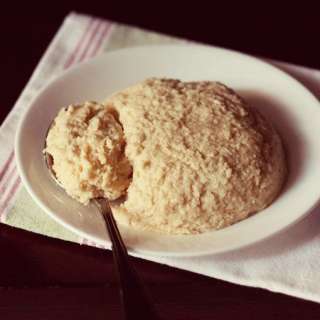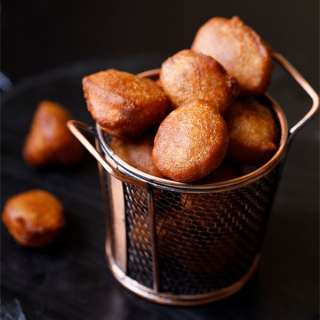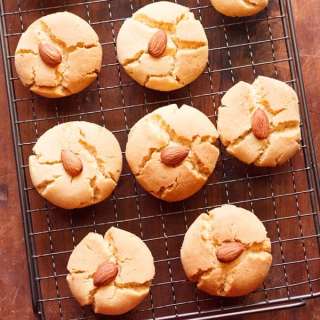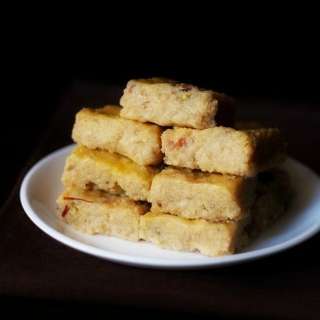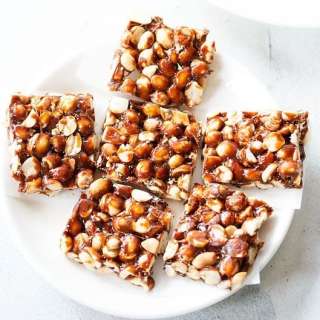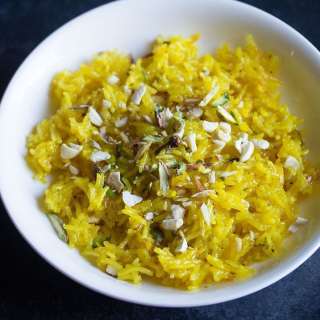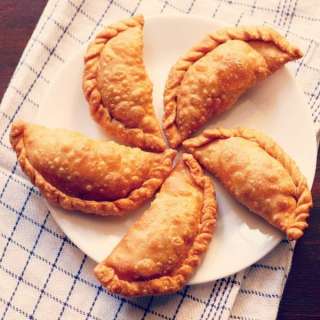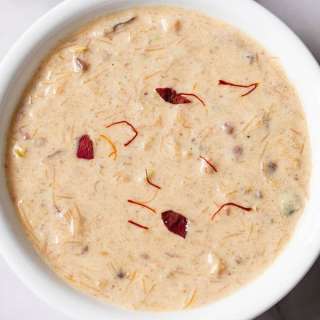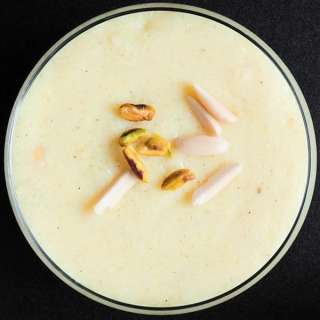
Rabdi Recipe | Traditional Rabri
User Reviews
4.9
99 reviews
Excellent

Rabdi Recipe | Traditional Rabri
Report
Rabdi or rabri is a classic, traditional North Indian sweet of thickened sweetened milk filled with layers of clotted cream (malai). It is also known as lachha rabdi in Hindi language and made by slow cooking milk in a large surfaced pan, until the milk reduces and thickens.
Share:
Ingredients
- 1.25 litres whole milk
- 2.5 to 3 tablespoons sugar or add as required
- ½ teaspoon cardamom powder or 5 to 6 green cardamoms, crushed in mortar-pestle
- 12 to 15 saffron strands (kesar) - crushed
- 1 teaspoon rose water or kewra water (pandanus water)
- 2 tablespoons almonds (badam) - blanched and sliced
- 2 tablespoons pistachios (pista) - blanched and sliced
Instructions
Prep nuts
- Soak almonds and pistachios in hot water for 20 to 30 minutes. Drain the water. Then remove the peels from the nuts.
- Slice or sliver or chop them and set aside.
Cooking milk to half of its volume
- Take whole milk in a thick bottomed kadai or pan and begun to heat the milk on a low to medium heat, till the milk starts to froth or form a layer of clotted cream (malai) on top. Stir a couple of time when the milk is getting heated.
- So when you will see the cream floating on top, then with a spatula, gently move the cream layer.
- Bring it towards the side of the pan and stick it to the pan. Keep the heat to a low and continue to simmer.
- Keep on simmering the milk like this and collecting the cream layer on the sides.
- This process of collecting the cream layer has to be done many times. continuous simmering of the milk will bring the cream on top and you have to bring and stick it to the sides of the pan.
- In between also stir the milk gently on occasions, so that the milk does not get burnt from the bottom. If you do too much of stirring and if quickly, then you won't get the layers of cream in the rabri.
- So after you have moved the layer of cream (malai) to the side of the pan, then stir the milk a few times. Then wait until another layer of cream forms on the surface of the milk.
- You can also just thicken and scrape the milk solids from the sides but in this case you won't get the layers of clotted cream or malai in the rabdi.
Making rabdi recipe
- Once the milk reduces to half, then add sugar. You can add sugar as per your taste preferences.
- Then add crushed saffron strands and cardamom powder. Stir gently.
- Continue collecting the cream and bringing it to the sides of the pan. Also do stir the milk gently after you bring the cream towards the sides of the pan. If you don't stir the milk then there is a possibility of the milk getting browned or burnt from the bottom.
- After adding saffron, the color will change gradually to a beautiful yellow color as the milk keeps on reducing.
- When the milk gets reduced to ⅓ or ¼ of its original quantity, then switch off the heat. It took me about 1 hour 15 minutes on a low heat initially and medium heat towards the latter stage. I cooked it until ⅓ of its original volume.
- The cream layer will be collected on the sides with a spatula. Scrape off the entire cream layer as well as dried milk solids and add into the thickened milk.
- Stir gently. Then add the sliced almonds, pistachios and 1 teaspoon rose water or kewra water. Stir gently again. Reserve a few of the blanched and slivered nuts for garnish
Serving and Storage Suggestions
- Garnish with some of the blanched almond and pistachio slivers. Serve rabdi hot or warm.
- If you are not serving hot or warm, let rabri cool at room temperature first. Transfer the cooled rabdi in an air-tight steel container and refrigerate it for a few hours.
- Keep in mind that it will thicken more as it cools at room temperature and even in the refrigerator. So keep the consistency slightly thin if you want to refrigerate it and serve cold or chilled.
- Whether you serve hot or warm or cold, if you prefer, garnish rabdi with some of the blanched, slivered nuts and sprinkle a bit of crushed saffron from top.
- Rabdi keeps well in the refrigerator for about 3 to 4 days. Store any leftover in an air-tight container or bowl in the fridge.
Notes
- Use whole milk or full fat milk. Don't make this sweet with low-fat milk or skimmed milk.
- You have to slow simmer milk on a low heat to ensure that it does not brown or burn at the bottom. You do need to stir so that the milk does not burn at the bottom of the pan. But when you see the layer of malai or clotted cream forming on the top of the milk, then do not stir. Stirring will break this layer. When the layer is properly formed, then gently bring it to the side of the pan with a spatula. After that you can stir the milk a few times until you see the next layer of malai forming.
- Feel free to add nuts and flavorings that you have. You can add slivered or chopped almonds, cashews, pistachios and pine nuts. For flavorings, you can mix and match or add only one flavoring ingredient. The options are cardamom powder, rose water, vanilla extract, kewra water (pandanus water) or saffron.
- You can choose to skip blanching the nuts. Simply slice or sliver them and add to the rabdi when you add saffron.
- As is this recipe serves 3. You can scale it to make 6 servings or more. Remember if you scale up the recipe, it will take more time for the milk to thicken and condense.
- Pan: Use a pan having a larger surface area as it helps in the evaporation process and speeds it up. A kadai or wok is the best pan that you can use as they have a larger surface area. Also keep in mind that the pan should be heavy or have a thick bottom so that the milk does not burn while cooking.
- Milk: Use whole milk or full fat milk. Don't make this sweet with low-fat milk or skimmed milk.
- Cooking: You have to slow simmer milk on a low heat to ensure that it does not brown or burn at the bottom. You do need to stir so that the milk does not burn at the bottom of the pan. But when you see the layer of malai or clotted cream forming on the top of the milk, then do not stir. Stirring will break this layer. When the layer is properly formed, then gently bring it to the side of the pan with a spatula. After that you can stir the milk a few times until you see the next layer of malai forming.
- Nuts and flavorings: Feel free to add nuts and flavorings that you have. You can add slivered or chopped almonds, cashews, pistachios and pine nuts. For flavorings, you can mix and match or add only one flavoring ingredient. The options are cardamom powder, rose water, vanilla extract, kewra water (pandanus water) or saffron.
- Blanching nuts: You can choose to skip blanching the nuts. Simply slice or sliver them and add to the rabdi when you add saffron.
- Scaling: As is this recipe serves 3. You can scale it to make 6 servings or more. Remember if you scale up the recipe, it will take more time for the milk to thicken and condense.
Nutrition Information
Show Details
Calories
136kcal
(7%)
Carbohydrates
15g
(5%)
Protein
4g
(8%)
Fat
8g
(12%)
Saturated Fat
1g
(5%)
Polyunsaturated Fat
2g
Monounsaturated Fat
4g
Cholesterol
1mg
(0%)
Sodium
1mg
(0%)
Potassium
157mg
(4%)
Fiber
2g
(8%)
Sugar
11g
(22%)
Vitamin A
27IU
(1%)
Vitamin B1 (Thiamine)
1mg
Vitamin B2 (Riboflavin)
1mg
Vitamin B3 (Niacin)
1mg
Vitamin B6
1mg
Vitamin B12
1µg
Vitamin C
1mg
(1%)
Vitamin D
1µg
Vitamin E
2mg
Vitamin K
1µg
Calcium
31mg
(3%)
Vitamin B9 (Folate)
9µg
Iron
1mg
(6%)
Magnesium
30mg
Phosphorus
80mg
Zinc
1mg
Nutrition Facts
Serving: 3Serving
Amount Per Serving
Calories 136 kcal
% Daily Value*
| Calories | 136kcal | 7% |
| Carbohydrates | 15g | 5% |
| Protein | 4g | 8% |
| Fat | 8g | 12% |
| Saturated Fat | 1g | 5% |
| Polyunsaturated Fat | 2g | 12% |
| Monounsaturated Fat | 4g | 20% |
| Cholesterol | 1mg | 0% |
| Sodium | 1mg | 0% |
| Potassium | 157mg | 3% |
| Fiber | 2g | 8% |
| Sugar | 11g | 22% |
| Vitamin A | 27IU | 1% |
| Vitamin B1 (Thiamine) | 1mg | |
| Vitamin B2 (Riboflavin) | 1mg | |
| Vitamin B3 (Niacin) | 1mg | |
| Vitamin B6 | 1mg | |
| Vitamin B12 | 1µg | 42% |
| Vitamin C | 1mg | 1% |
| Vitamin D | 1µg | 5% |
| Vitamin E | 2mg | |
| Vitamin K | 1µg | |
| Calcium | 31mg | 3% |
| Vitamin B9 (Folate) | 9µg | |
| Iron | 1mg | 6% |
| Magnesium | 30mg | 8% |
| Phosphorus | 80mg | |
| Zinc | 1mg |
* Percent Daily Values are based on a 2,000 calorie diet.
Genuine Reviews
User Reviews
Overall Rating
4.9
99 reviews
Excellent
Other Recipes


